|
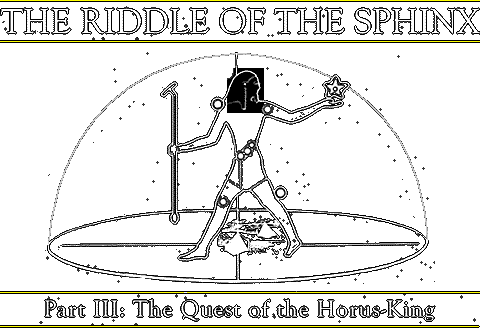

Editorial
|
Fragments
|
Cahokia II
|
Piasa Creature II
|
Sphinx III
Register
for our Hall of Records Newsletter!
Questions? Comments? Suggestions? Advertising? Press Releases?
Contact us!
The Riddle of the Sphinx Part I
|
Part II
|
Part III
|
Part IV
 gyptian religion, as we have seen in parts
one
and
two
of this series, was essentially astronomical in
nature. It is clear from even the most basic study of astronomy and architecture that the ancient
Egyptians built the pyramids, Sphinx, and possibly other structures in such a way so as to imitate
the stars in the sky, to the point where many now believe that they were attempting to make a "heaven
on earth" in a very real sense.
gyptian religion, as we have seen in parts
one
and
two
of this series, was essentially astronomical in
nature. It is clear from even the most basic study of astronomy and architecture that the ancient
Egyptians built the pyramids, Sphinx, and possibly other structures in such a way so as to imitate
the stars in the sky, to the point where many now believe that they were attempting to make a "heaven
on earth" in a very real sense.
In
part one
of this series, we saw how the three great pyramids were laid out in such a way as to mimic
the three belt stars of Orion. In
part two, we saw how the constellation of Orion sat at the center of
the Egyptian astronomical religion. Now it remains to be seen exactly why the ancient Egyptians expended
so much effort in order to built these massive structures.
Not only the layout of the Giza necropolis but many major pyramids — even the Nile itself — may have
been used by the ancient Egyptians to mirror many major star patterns, such as the belt stars of Orion,
(the three great pyramids); the Hyades cluster in Taurus (the Dahshur group of pyramids, which include
the peculiar Bent and Red pyramids; the horns of Taurus, including El Nath (northern horn) and Zeta Taurus
(southern horn), which may be represented by structures in Memphis and Ayan; and, interestingly, the Nile
itself, which was believed by the ancient Egyptians to be the earthly counterpart of the Milky Way.

Moreover, as discovered by Robert Bauval in his ground breaking book,
The Orion Mystery,
there is even more to the sky-ground connection — within the Great Pyramid itself. Bauval explains,
"In the Great Pyramid are four protracted and narrow channels or shafts which have long baffled
Egyptologists.... The two shafts within the King's Chamber had been known since the early seventeenth
century.... At first they thought the shafts led to a room ... but abandoned this idea when the air
rushed through the chamber after they had cleared the southern shaft. They then decided, erroneously,
that the shafts had been designed for ventilation, and coined the term air-shafts.1
Two more shafts, this time in the Queen's chamber, were found in 1872 by a British engineer named Waynman
Dixon, but these
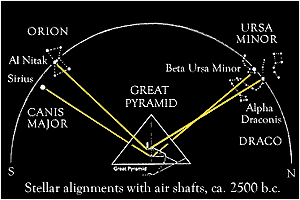
Cross section of the Pyramid of Khufu. The "air shafts" located on the northern and southern walls
of the King's Chamber and the Queen's Chamber were formerly thought to be for ventilation purposes.
However, recent investigations have revealed that these shafts were actually celestial time-markers,
pin-pointing the time of the construction of the Giza pyramids. These shafts actually point at
several major stars in the northern and southern skies which, due to precession, were only aligned
with the shafts during the epoch of 2450 b.c. This aligns perfectly with the accepted date for the
construction of the Giza pyramids, neatly confirming this theory.
Image adapted from
The Message of the Sphinx,
copyright 1996
Graham Hancock
and
Robert Bauval
|
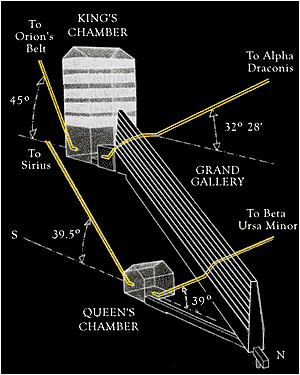
A closeup of the interior structure of the Khufu pyramid, with a detailed look at the
paths of the shafts relative to the inner chambers.
Image adapted from
The Orion Mystery,
copyright 1995
Robert Bauval
and Adrian Gilbert
|
shafts had been hidden behind several inches of stone, and therefore had clearly not been intended as
air shafts. Yet, the air shaft theory continued on for decades longer.
In 1964,
Dr. Alexander Badawy, a renowned architect and Egyptologist, was the first to suggest that the
shafts might have had some sort of ritual function. He pointed out that not only did the northern shafts point at
important stars near the north celestial pole, the southern shafts point at the constellation of
Orion. Furthermore, Badawy's experience in studying Egyptian architecture made him uniquely suited to
pass judgement on the feasibility of the "Air Shaft" hypothesis. "Badawy's architectural studies had
shown that the ancient Egyptians did not ventilate tombs."2
Virginia Trimble,
coauthor of the article that first revealed this hypothesis, calculated that the belt stars of Orion,
Al Nitak, Al Nilam, and Mintaka, would have been aligned with the southern shaft in the King's Chamber
around 2500 b.c., corresponding with the generally accepted date for the building of the pyramids.
This was due to the fact that the constellation of Orion (and all stars) change their rising and setting
points on the horizon over time, due to the phenomenon of precession
(click
here
for a detailed explanation of precession), which allowed Trimble the ability to calculate in exactly
what epoch — give or take a century — the belt stars in the constellation of Orion would have been high
enough over the horizon to be in line with the southern shaft in the King's Chamber.
Bauval later followed up on their discoveries in
The Orion Mystery,
adding his own discovery to the mix, that the three main pyramids at Giza
were laid out in such a way so as to act as earthly representations of the belt stars of Orion (see
part one).
He further elucidated that the ancient Egyptians' knowledge of precession, as hard coded (literally)
into the rocks of the Giza plateau, had been used by them as a means of marking significant points in
their history — as a sort of celestial "calendar". But were there other important events marked by the
pyramids and Sphinx that were yet to be found?

From here, Bauval teamed up with Graham Hancock to collate and resolve all of the extant data on the
clues regarding the riddle of the Sphinx in their seminal work,
The Message of the Sphinx
(1996).
Hancock and Bauval did not arrive at their conclusions only through observing the correlations between
the layouts of various internal and external pyramidal structures and certain star patterns, however.
These observable correlations were, so to speak, only the tip of the pyramid. Once they had confirmed
these correlations, far from having solved the riddle of the Sphinx, they realized that they were now
only beginning "initiates" into an ancient Egyptian mystery school, a school whose graduation
requirements required a wholistic understanding of ancient Egyptian religion, myth, and history.

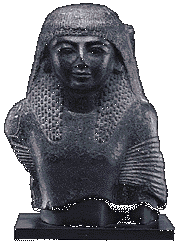
An Egyptian priest.
|
We saw in
part two
how that before the advent of the reign of mortal kings in Egypt, the ancient Egyptians
believed that Egypt had been reigned over by a race of semi-divine beings called the Shemsu Hor, or
"Followers of Horus". These beings, Hancock and Bauval concluded, were an ancient society of astronomer-
priests, who manipulated Egyptian history and culture from behind the scenes in order to keep their ancient
wisdom alive. By engineering Egyptian society from behind the scenes from their base in Heliopolis,
creating and maintaining the state religion through a carefully trained priesthood, the Shemsu Hor were able
to create such massive monuments as the pyramids and Sphinx, so that their scientific knowledge was, quite
literally, "set in stone". As Hancock and Bauval were soon to discover, this knowledge still exists to this
day; for thousands of years, the Sphinx had sat quietly, waiting for someone with the courage and tenacity
to solve its riddle.

Through careful study of ancient Egyptian religious texts, specifically the Pyramid Texts, Hancock and Bauval
were able to begin to discern a pattern emerging that involved a "sky-ground" dualism that matched the dualism
apparent in the layout of the pyramids and Sphinx. Furthermore, it became increasingly clear that the
Heliopolitan Priesthood well understood the concept of precession; it is even possible that it lay at the
very heart of their astronomical religion, that precession was one of the "greater mysteries" of their faith.
(Click
here
for a detailed explanation of precession.)
As Hancock and Bauval proceeded in the quest, they discovered that this was indeed the case, and that the
entire purpose of the Quest of the Horus King was to use the clues left behind by his ancestors to solve the
riddle of the Sphinx, and to find the treasures that the answer to that riddle would reveal.

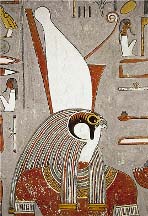
The god Horus, wearing the Pharaonic crown of Upper and Lower Egypt. The pharaoh was considered
to be the incarnation of the god Horus, son of Osiris, and undertook the Quest in order to prepare
himself to be reunited with his heavenly father (Orion/Osiris) in death.
|
|
Through their study of the pyramid texts, Hancock and Bauval were convinced that all of the pharaohs, as a
part of their office, underwent an initiation that had the purpose of initiating them into the mysteries of
the ancient astronomical religion of the Heliopolitan priesthood, the "Followers of Horus". As such, the
pharaoh was to undergo a religious ritual, wherein he was transformed, ritually, into the "Horus-King", the
embodiment of the Egyptian god Horus on Earth. Horus was the son of Osiris, the chief of the Egyptian deities,
and the pharaoh was believed to be his earthly incarnation. And it was each pharaoh's responsibility to
undergo the Quest of the Horus-King in order to become fully initiated into the religion of the Egyptians.
Part of this ritual, it is believed, was a knowledge of the deepest mysteries of Egypt, including the
deepest mystery of all, the riddle of the Sphinx.
The Horus-King, in order to find the answer to the riddle, must first, in effect, travel back to the "First Time" — what the ancient
Egyptians believed to be the beginning of their history. It is here, they believed, that the answer to the
riddle might be found. Hancock and Bauval explain, "We wonder whether it is possible that the quest of the
Horus-King might have had as its ultimate objective the acquisition of knowledge concerning the
'First Time' — perhaps even the acquisition of specific knowledge from that remote epoch when the
gods had walked the earth."3
Hancock and Bauval came upon this idea from the Pyramid Texts, ancient texts that been found inscribed on the
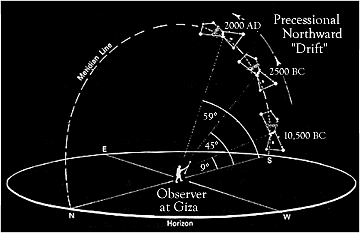
The Horus-King, who had been taught the concept of precession as a part of his training, was now
able to imagine how Osiris-Orion "moved" up and down in the sky relative to the earthbound viewer
over the 25,920-year precessional cycle. As such, he could envision in his mind's eye how the sky
would appear at any time in history, past or future.
|
inner walls of the pyramid of Pharaoh Unas (c. 2356 — 2323 BC) in Saqqara. These texts were intended to give
the dead Pharaoah instructions on what he needs to do in the afterlife to attain eternal life. However, they
believed that these instructions had a very real earthly meaning as well. Hancock and Bauval explain that,
according to the Pyramid texts, "We are told that the Horus-King must 'travel upstream' — i.e., must push
against the natural drift of 'time' — in order to reach Orion-Osiris in his proper 'First Time'
setting.4 As we saw with the above
Orion animation,
over millenniums of time, the constellation of
Orion appears to literally "move upstream" against the Nile's heavenly counterpart, the "Milky Way".
Using this mental image of the constellation of Orion traveling "upstream" (or downstream), the Horus King
initiate was able to view in his mind's eye how the stars would look relative to the earthbound observer at any
time in history.
Betake yourself to the Waterway, fare upstream [south], travel about Abydos in this spirit-form of yours
which the gods command to belong to you; may a stairway [road] to the Duat [the Egyptian "heaven"]
be set up for you in the place where Orion Is.... Betake youself to the Waterway, fare upstream ... traverse
Abydos. The celestial portal to the Horizon is open to you ... may you remove yourself to the sky, for the
roads of the celestial expanses which lead up to Horus are cleaned for you ... for you have traversed the
Winding Waterway [Milky Way] which is in the north of the sky as a star crossing the sea which is beneath
the sky. The Duat has grasped your hand at the Place Where Orion Is.5
In the final installment of the Riddle of the Sphinx, we will complete The Quest of the Horus King, and see
how the quest had as its ultimate prize the Hall of Records, a sacred place hidden somewhere underneath the
Giza plateau, that some believe may still hold secrets from times unremembered, possibly from the time
before the Flood. 
The Riddle of the Sphinx Part I
|
Part II
|
Part III
|
Part IV
Editorial
|
Fragments
|
Cahokia II
|
Piasa Creature II
|
Sphinx III
Register
for our Hall of Records Newsletter!
Questions? Comments? Suggestions? Advertising? Press Releases?
Contact us!
Notes

1
Robert Bauval, Adrian Gilbert
The Orion Mystery: Unlocking the Secrets of the Pyramid (New York: Three Rivers Press, 1994), 97.
2
Bauval, Gilbert
The Orion Mystery, 101.
3
Graham Hancock, Robert Bauval,
The Message of the Sphinx: A Quest for the Hidden Legacy Of Mankind
(New York: Crown Publishers, 1996), 232.
4
Hancock, Bauval,
The Message of the Sphinx, 232.
5
Hancock, Bauval,
The Message of the Sphinx, 232.



 The Message of the Sphinx:
The Message of the Sphinx:
A Quest for the Hidden Legacy of Mankind
(1997)
Graham Hancock, Robert Bauval
Rating:
    
A provocative new approach to Egyptology argues that the ancient
structures at Giza may be much older than originally thought and that their
alignment may be a cryptic message directed toward a mysterious underground chamber
recently detected beneath the Sphinx. In this riveting account of historical and
archaeological investigation, the authors present hard evidence that the Sphinx, the
Pyramids, and the other monuments at Giza are of far more ancient origin than previously
believed. Complete with evidence of a conspiracy between the Egyptology establishment
and various confidential organizations to keep the secrets of the Pyramids from the world,
The Message of the Sphinx is also a modern-day detective story. This popular book has
received many good reviews, and is personally recommended by the publisher.
Click
here
to buy this book.
 The Orion Mystery:
The Orion Mystery:
Unlocking the Secrets of the Pyramids
(1995)
by Robert Bauval, Adrian Gilbert (Contributor), Peter Ginna (Editor)
Rating:
    
This fascinating archaeological detective story argues that the great pyramids
of Egypt's Fourth Dynasty (c. 26002400 b.c.) were vast astronomically
sophisticated temples, rather than the pharaonic tombs depicted by
conventional Egyptology. Mysterious airshafts, which lead from the Great Pyramid's
chambers to its exterior were sited, the authors argue, to coincide with the key stars of
Orion, a constellation that had religious significance for the Egyptians. Using
astronomical data about stellar movement, they argue that the Orion stars
coincide exactly with the pyramids' positions in approximately 10,400 b.c.--a
period the Egyptians called the First Time, when they believed the god Osiris
ruled the Earth. This excellent book makes a good companion volume to Hancock's
"The Message of the Sphinx", which it preceded.
Click
here
to buy this book.
 The Serpent in the Sky:
The Serpent in the Sky:
The High Wisdom of Ancient Egypt (1993)
Rating:
   
John Anthony West
This revised edition of West's revolutionary reinterpretation of the civilization of Egypt
challenges all that has been accpeted as dogma concerning this ancient and enigmatic
land. It features a new introduction linking Egyptian science with the perennial wisdom
tradition and an appendix updating the author's work in redating the Sphinx.
Illustrations.
Click
here
to buy this book.
 Riddles of the Sphinx (1998)
Riddles of the Sphinx (1998)
Paul Jordan, John Ross (Photographer)
Rating:
   
This book tells the full story of the Great Sphinx of Giza as Egyptology has
uncovered it. The Sphinx is one of the most striking monuments of the ancient
Egyptians, and has attracted the attention of travellers, scientists, archaeologists
and others for generations. Paul Jordan details the Sphinx's impact on the
ancient world, on Arab writers, on Renaissance travellers, on the pioneers of
Egyptology and on modern scholarship. He tells the story of the Sphinx's many
bouts of excavation and restoration, and above all puts the Sphinx in the
context of all that is known about ancient Egyptian history and religion. This
book examines every aspect of the Sphinx, including a professional geologist's
recent claims regarding its age, and provides an authoritative and highly
readable overview of the issues and debates currently surrounding it.
Click
here
to buy this book.
 History of Egypt
History of Egypt
Manetho, W. G. Waddell (Translator)
Rating:
   
Manetho was an Egyptian of the 3rd century b.c. Born probably at Sebennytus in the Delta, he became a
priest or high priest at Heliopolis. Eight works or parts of works were ascribed to him, all on history
and religion and all apparently in Greek. These survive only as quoted by other writers.
This volume includes both the English translation and the original Greek, and also contains the doubtful
Kings of Thebes (in Egypt) and the Old Chronicle. This small but important book is highly
recommended by the publisher.
Click
here
to buy this book.
 Temples of Ancient Egypt
Temples of Ancient Egypt
Dieter Arnold (Editor), Lanny Bell,
Ragnhild Bjerre Finnestad (Editor), Byron E. Shafer (Editor)
Five distinguished scholars here summarize the state of current knowledge about ancient Egyptian temples and the rituals associated with their use. The first volume in English to survey the major types of Egyptian temples from the Old Kingdom to the Roman period, it offers a unique perspective on ritual and its cultural significance. The authors perceive temples as loci for the creative interplay of sacred space and sacred time. They regard as unacceptable the traditional division of the temples into the categories of "mortuary" and "divine," believing that their functions and symbolic representations were, at once, too varied and too intertwined.
Click
here
to buy this book.
 Beyond the Blue Horizon:
Beyond the Blue Horizon:
Myths & Legends of the Sun, Moon, Stars, and Planets (1991)
E.C. Krupp
Rating:
   
Beyond the Blue Horizon is a treasure trove of myths, legends, and stories in which people have, through
the ages, attempted to understand the cosmos and its meaning for humankind. Collecting an astonishing
amount of lore between the covers of a single book, Krupp explains why our ancestors were so intrigued
by the heavens, and what their celestial stories meant. An epic, authoritative, and cross-cultural
exploration with over 150 illustrations, Beyond the Blue Horizon tells how all civilizations searched
the sky to understand the universe - and our place in it.
Click
here
to buy this book.
 The Cambridge Star Atlas (1996)
The Cambridge Star Atlas (1996)
Wil Tirion
After having established itself as a standard star atlas, "The Cambridge Star Atlas"
by internationally famous astronomical cartographer, Wil Tirion, has now been
improved. The popularity of this book, first published in 1991, is that it covers the
entire sky, both northern and southern latitudes, in an attractive format suitable for
beginning as well as experienced astronomical observers. The basis of the book is a
series of twelve monthly sky charts, followed by an atlas of the whole sky, arranged in
twenty overlapping charts. Each chart shows stars down to magnitude 6.5, together
with about 900 nonstellar objects, such as clusters and galaxies, that can be seen with
binoculars or a small telescope. There is also a comprehensive double-page map of
the Moon's surface, showing craters and other named features. For this edition, author
Tirion has added more detail to the monthly charts, and has included "all-sky" charts of
interesting patches of sky in the northern and southern hemispheres. This book is the
ideal reference atlas for sky watchers everywhere.
Click
here
to buy this book.
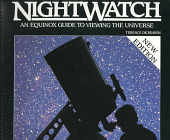 NightWatch (1989)
NightWatch (1989)
Terence Dickinson
Dickinson, a renowned writer and former planetarium astronomer teaches you all the
basics to start gazing, including: key facts of stargazing equipment (binoculars and
telescopes), 24 seasonal star charts, "the universe in eleven steps", chapters on the
planets; moon & sun; eclipses; comets, meteors & auroras; photographing the night
sky; and essential resources.
Click
here
to buy this book.
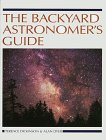 The Backyard Astronomer's Guide (1991)
The Backyard Astronomer's Guide (1991)
Terence Dickinson, Alan Dyer, Barry Estabrook (Editor)
An essential reference tool for both beginning and veteran sky observers. Drawing on
decades of stargazing experience, the authors suggest what equipment to buy and
what to avoid, describe observing techniques, and explain how to hunt down the most
interesting celestial objects. Each chapter is illustrated with the latest, breathtaking
astrophotography. This book is recommended as an excellent companion to "NightWatch" (above).
Click
here
to buy this book.
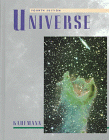 Universe
Universe
4th Edition (1993)
William J. Kaufmann III
Rating:
    
This oversized tome is an excellent introductory overview of all aspects of modern astronomy.
I first encountered this book as a textbook to an introductory astronomy class, and it has
been an indispensable tool ever since, as it has to countless other students of astronomy.
This popular book has received many good reviews, and is personally recommended by the
publisher.
Click
here
to buy this book.
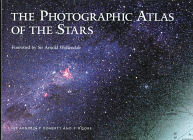 The Photographic Atlas of the Stars (UK edition) (1997)
The Photographic Atlas of the Stars (UK edition) (1997)
by P. Doherty (Contributor), P. Moore (Contributor), H. J. P. Arnold (Photographer)
Presents the whole of the night sky in 45 color photographs taken through a 33mm lens, so that the field of view is similar to that of the naked eye. Each photograph is accompanied on the facing page by a map based on a negative print of that photograph, labeled to show the main stars of the constellations. These double-page spreads are preceded by commentary (written by author and BBC broadcaster Patrick Moore) and by tables which provide details of bright stars, double- stars, variable stars and deep-sky objects that may be seen with the naked eye or through binoculars. (Review by Amazon.com)
Click
here
to buy this book.


 Passion: Music for the Last Temptation of Christ
Passion: Music for the Last Temptation of Christ
Peter Gabriel
Rating:
    
This CD received superb reviews (5 stars) and is personally recommended by the publisher.
(The background music on this page is from "The Feeling Begins", the first track of this CD.)
Click
here
to buy this music.
 Passion: Sources
Passion: Sources
Peter Gabriel/Realworld Music
Rating:
   
This excellent CD is a compilation of much of the source recordings that Peter Gabriel
used for Passion (above). A must-have for lovers of world music, especially African and
Middle-Eastern music.
Click
here
to buy this music.
 The Musicians of the Nile: Luxor to Isna
The Musicians of the Nile: Luxor to Isna
Musicians of the Nile
Rating:
   
Life in the villages spread out along the Nile hasn't changed in a thousand years; nor
for that matter has the traditional music of the region which has remained impervious to
outside influences, even Islamic ones. The recordings here weren't collected on site but
captured live at a Paris concert and in Real World's own studios in darkest Wiltshire.
No concessions are made to Western ears, however, other than upping the playback
quality of the intricate tabla rhythms as they tangle with ancient instruments like the
rababa, the droning oboe-like mizmar and the flutish arghul which goes all the way
back to the Pharaohs. Not so much a record, more like an adventure in sound. This
soundtrack is highly recommended by the publisher.
Click
here
to buy this music.


 The Mystery of the Sphinx
(1993)
The Mystery of the Sphinx
(1993)
John Anthony West, with Robert Schoch
Rating:
    
Click
here
for a sound sample!
The Mystery of the Sphinx contains information about the Sphinx, and Egyptian history and
archaeology in general, that is nothing less than explosive. John Anthony West and Robert
Schoch offer brilliant and convincing evidence that the Sphinx is much older than the
pyramids, possibly as much as 8,000 years older than previously thought, indicating that
our understanding of Egyptian history and religion has barely scratched the surface. Their
convincing testimony is made all the more interesting and entertaining by the inclusion
of Charlton Heston as the narrator. And this video is not merely a visual montage of Egyptian
images overlaid with mystical-sounding rhetoric. This is real science and real history -
and maverick archaeology at its best. This popular video is highly recommended by the
publisher.
Click
here
to buy this video.
Sphinx of Egypt
Part of the popular "In Search of History" series.
Click
here
to buy this video.
|
